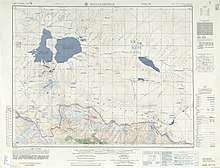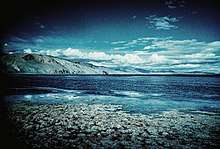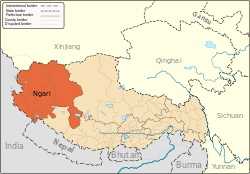Burang County
Burang County (Standard Tibetan: སྤུ་ཧྲེང་རྫོང;[3] Chinese: 普兰县) is called Purang[4] in Tibetan, and the county capital is also known as Burang or Purang in Tibetan and Taklakot in Nepali.[5] It is an administrative division of Ngari Prefecture in the Tibet Autonomous Region (TAR) of China. The county covers an area of 12,539 square kilometres (4,841 sq mi), and has a population of 9,657 as of 2010.[1][2]
Burang County སྤུ་ཧྲེང་རྫོང · 普兰县 | |
|---|---|
County | |
 Gurla Mandhata 7,694 metres (25,243 ft) | |
.png) Location of Burang County within Tibet | |
| Coordinates (Burang County government): 30°17′25″N 81°10′38″E | |
| Country | People's Republic of China |
| Autonomous region | Tibet |
| Prefecture | Ngari |
| Seat | Burang Town |
| Area | |
| • Total | 12,539 km2 (4,841 sq mi) |
| Population (2010)[2] | |
| • Total | 9,657 |
| • Density | 0.77/km2 (2.0/sq mi) |
| Time zone | UTC+8 (China Standard) |
| Postal code | 859500 |
| Website | http://pl.al.gov.cn/ |
| Burang County | |||||||||||
|---|---|---|---|---|---|---|---|---|---|---|---|
| Chinese name | |||||||||||
| Simplified Chinese | 普兰县 | ||||||||||
| Traditional Chinese | 普蘭縣 | ||||||||||
| |||||||||||
| Tibetan name | |||||||||||
| Tibetan | སྤུ་ཧྲེང་རྫོང | ||||||||||
| |||||||||||
Geography
Political geography
Burang County has TAR's south-western border with Nepal's Sudurpashchim and Karnali province, Darchula, Bajhang and Humla District. Further west, India's Uttarakhand State, Pithoragarh district borders. Buddhist, Hindu and Jain pilgrims going to Lake Manasarovar and Mount Kailash enter from Nepal via Simikot,[6] and from India via Dharchula.[7]
The county is bounded by other counties in the Ngari Prefecture, including Zanda to the west, Gar to the northwest and Gê'gyai to the north.[1] To the east is Zhongba County of Shigatse Prefecture.[1]
Physical geography
The county covers an area of 12,539 square kilometres (4,841 sq mi), and has a population of some 9,058 people as of 2010.[1][2] The county seat, located in the Jirang Neighborhood Committee,[1] is located only 20 kilometres (12 mi) from Nepalese territory, and 450 kilometres (280 mi) north-west of Kathmandu. It is an important Chinese customs point between Tibet, Nepal and India. Much of the county consists of river valleys of mountains and lakes such as Kangrinboqê (also known as Mount Kailash), The Naimonany Peak Gunrla and Lake Maponen Yamco Lake Manasarowar. The Karnali River is also a prominent geographical feature of the landscape. Wildlife commonly seen in the far south-western Tibetan county are wild donkeys, wild yaks, yellow goats, antelope, rock goat, lynxes, foxes, leopards and marmots.
Climate
The annual average temperature in the county is −3.5 °C (25.7 °F), and annual precipitation averages 100 mm (3.9 in).[1]
Administrative Divisions
The county is divided into Burang Town, Parga Township, and Hor Township.[1] The county government is seated in the Jirang Neighborhood Committee in Burang Town.[1]
History

Some historians believe that Tegla kar (Lying Tiger fort) near Burang was built during the Zhangzhung dynasty which was conquered by the Tibetan king Songtsen Gampo in the early 7th century CE. It became the main fort of the Burang (Purang) Kingdom, in the 10th century under King Kori, one of the two sons of Tashi Gon, King of the Guge Kingdom. The Guge and Burang kingdoms were separated about the late 11th century, when king Logtsha Tsensong founded an independent realm. In about 1330 the 13th king Sonam De took over the important Malla kingdom (alias Yatse; not to be confused with the Malla dynasty of central Nepal) in western Nepal on the extinction of the local dynasty. The dynasty of Burang kings died out shortly before 1376. The territory was subsequently dominated in turns by the neighbouring kingdoms Guge and Mustang.[8]
Economy
In 2010, the county reported a GDP of 140 million Renminbi, fiscal revenue of 4.27 million Renminbi, and retail sales totaling 26.97 million Renminbi.[9]
Burang is an important barley-growing region and traditionally barley and salt from the salt lakes to the north of Taklakot made up the bulk of the trade to the south, while rice and a wide range of luxuries were traded back into Tibet from Nepal. The local villagers (known as Burangbas) carried the produce across the ranges into Nepal on caravans of sheep and goats during the summer and autumn.[10] Sheep and goats are fitted with double packs which can carry up to 30 kg (70 lb) of barley or salt on the 3 week journey to the terai or low-lands of Nepal.[11] In winter and early spring the region is often in total isolation, cut off by heavy snow falls.
Transport
China National Highway 219 passes through the county.[1]
References
- 普兰县概况地图. xzqh.org. 2016-03-01. Archived from the original on 2020-06-17. Retrieved 2020-06-17.
- 普兰县历史沿革. xzqh.org (in Chinese). 2016-04-05. Archived from the original on 2020-06-17. Retrieved 2020-06-17.
- "Ngari prefecture". Geographical names of Tibet AR (China). Institute of the Estonian Language. 2018-06-03. Retrieved 9 January 2020.
- Kunsang Tenzin, Paul Eckert (9 September 2019). "Nepal Deports 6 Tibetan Asylum Seekers to China". Radio Free Asia. Translated by Dorjee Damdul. Retrieved 27 May 2020.
The six had crossed the Nepali border from Purang (In Chinese, Burang) county in Ngari (Ari) prefecture.
CS1 maint: uses authors parameter (link) - Gyurme Dorje (1999). Footprnt Tibet Handbook (2nd ed.). Bath, England: Footprint Handbooks. ISBN 978-1-900949-33-0.
- Thubron, Colin (2011). To a Mountain in Tibet. New York: Harper Collins. Archived from the original on 2013-12-15. Retrieved Dec 14, 2013.
- "Kailash Mansarovar Yatra". India Tours Guide. Archived from the original on 22 December 2013. Retrieved 13 December 2013.
- R. Vitali (1996), The kingdoms of Gu.ge Pu.hrang. Dharamsala: Tho.ling gtsug.lag. In Tibetan (the text, from p. 1) and English (from p. 89)

- 西藏和平解放60周年:三国交界边境县普兰变了样. The Central People's Government of the People's Republic of China (in Chinese). 2011-05-09. Archived from the original on 2020-06-17. Retrieved 2020-06-17.
- von Fürer-Haimendorf, Christoph. (1975). Himalayan Traders: Life in Highland Nepal, pp. 251-256. John Murray, London. Reprint: 1988 Time Books International. New Delhi.
- Tibet Handbook, p. 352. (1999). Edited by Sarah Thorowgood. Passport Books, Chicago. ISBN 0-8442-2190-2.

